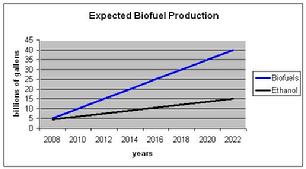|
Vincent Pica
Chief of Staff, First District, Southern Region (D1SR)
United States Coast Guard Auxiliary
|
|
Ethanol Use Going Up… Eek!?
Under legislation passed at the end of 2007, the Congress has mandated that 36 billion gallons of biofuels of all types – biodiesel, ethanol, cooking oil – be in use by 2022. That is up from 6 billion gallons of biofuel now in use or blended in with the 140 billion gallons of gasoline we used in 2007. Since we import about 2/3rds of the crude oil we use each year, upping our use of biofuels can make more than a “drop in the bucket” difference in our dependency on foreign energy sources (see test below!). But as my father used to say, “Vincent, there are no free lunches.”
|
 |
| click here to expand the chart |
|
| Ethanol – a Hydrophilic Solvent?
As you may be able to infer from the chart, ethanol is now the largest component of biofuels right now and is projected to be 15 billion gallons of the 36 billion gallons mandated by 2022. The use of biodiesel in marine diesel engines has not produced any issues that haven’t been quickly addressed.
|
A number of diesel engine manufacturers now certify that their engines are biodiesel-ready, at least up to “B5” or 5% biodiesel. Of course, diesels are famous for being able to turn just about any hydrocarbon into fuel…!
Ethanol is the problem, as well as part of the solution. It is “hydrophilic”, i.e., Greek for “water-lover”, as well as being a solvent… Yes, we’re putting solvents into our tanks and burning it. They combine to create quite a challenge for the private skipper (see SSP, “Ethanol/E10 – Back To The Future, With Care”, 1/31/07).
Industry monitors report that about half the filling stations in the country pump gasoline blended with 10% ethanol – E10. While new boats don’t have the serious problems that older boats have with their resin-infused fiberglass tanks dissolving due to the solvent action of E10, problems still develop because gasoline, as it sits (how many tanks of fuel do you go through in your car from Memorial Day to Labor Day – compared to your boat?), it creates other chemical substances – such as varnish, gummy deposits and what is universally called “gunk” by your mechanic. The solvent properties of ethanol generally will lift all that off the sides and bottoms of our tanks and send it towards the engine. Boat/US reports receiving numerous cases, and tow requests, from boaters who end up with an engine that won’t run properly or at all.
Also, the newest engines with high-pressure, direct-injection two-stroke power plants have particularly fine tolerances, which mean they are intolerant to small particles clogging the injectors. As I noted back on 1/31/07, you had better replace your standard fuel filters with “10-micron water separator filters designed for ethanol.” Those are the words you use when you order them. They fit exactly where the old filters went. And order plenty of them. Until E10 is finished cleaning the gunk out of your fuel system a little bit at a time, you’ll be changing those filters a couple of times a summer. Eventually, the system will be cleaned of years of crud and everything gets normal again. Except for the water problem…
|
By way of background, ethanol was put in gasoline for two reasons: first, we make it from corn we grow in the US (and that is a VERY powerful lobby that has been trying to push E10 to higher and higher levels – a coalition of concerned users, including boaters, have slowed the progression
|
|
by getting legislation in place to require the EPA to study the effects of E20 and higher on engines (E20 by itself is a killer for boat engines)) and, secondly, MTBE, which it replaced, turned out to be a carcinogen… But as Dad used to say, “Vincent, there is no free lunch.”
The problem is that E10 absorbs 10 times more water than MTBE does. This gets carried with your fuel into the engine where, hopefully, it gets burned away. If it sits in an aluminum fuel tank, it can cause corrosion and now there are little bits of metal moving through the system – clogging the fuel filters and damaging injectors, carburetors, etc… And if the water/E10 ratio gets too high, the water pulls the ethanol out of the E10 – leaving plain ol’ gasoline on top (with slightly less octane than the E10 combine) and water and ethanol sinking below. The lower octane isn’t good and no ethanol is getting burned with the gasoline – not good for the engine nor the environment. If enough water/ethanol collects in the fuel tank, it will eventually reach the engine. Neither water nor pure ethanol is good for an engine.
More Boating Is the Answer!
First, use a marina that pumps lots of gas. You don’t want to put his problem in your tank. Two, you’d better be using your boat more since this water build-up and separation risk is amplified by fuel just sitting there. (Here is a perfect excuse for not mowing the lawn!)
As to the mystery question noted at the top of the column, the five largest suppliers of crude oil to the US are: Canada, Saudi Arabia, Venezuela, Mexico and Nigeria. Put them in order… first to fifth… email me your answer – or look here next week!
|
BTW, if you are interested in being part of USCG Forces, email me at JoinUSCGAux@aol.com or go direct to the D1SR Human Resources department, who are in charge of new members matters, at DSO-HR and we will help you “get in this thing…”
|
| <-- click there to tweet, post or otherwise distribute to the 'net
|
|